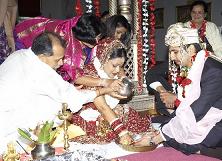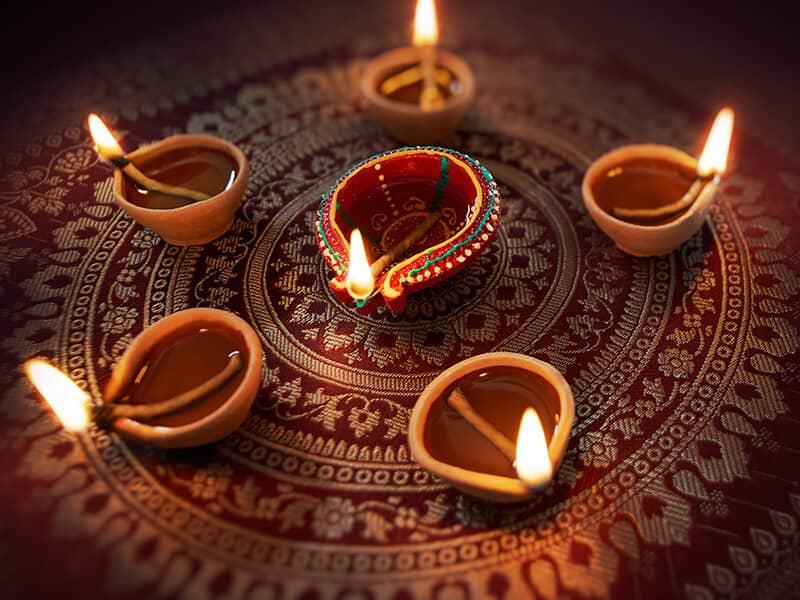And in the end, I was, in some sense, able to have my perfect wedding.
I’d met my husband at a club, and we dated for five years before we decided to tie the proverbial knot. Our discussions around marriage had focused more on where we would live (at my husband’s request, I decided to give living with my in-laws a go), how we would raise our children (apparently I will end up being the stricter parent), and how we did not want a large, splashy Indian wedding, something that's become stereotypically common.
We didn’t put too much importance on the day itself, realizing it’s mainly a symbolic event and a festive occasion for family and friends. The actual marriage entails two people making a life together.
My absolute dream wedding would have taken place in India. I grew up there, and I couldn’t even comprehend getting married in Toronto, where we live now. How would most of my family--who are in India--attend? Where would I go shopping? Where would I find a good mehendi artist?
The wedding ended up happening in Toronto for various logistical reasons. My husband and I insisted on a small, but meaningful ceremony.
Hindus from different parts of India have their own regional interpretations of a wedding ceremony, making them fairly distinct from each other. Usually, when Hindus from two different backgrounds marry, they incorporate all the regional variations. In our case, I took care of the wedding ceremony, while my husband planned the reception.
My husband’s family is Punjabi, and aren’t aware of all the religious rituals during the wedding. “We just follow what the pundit (priest) tells us,” one of my husband’s aunts told me. They focus more on the revelry –dancing, singing, applying turmeric paste on the groom as a beautification rite, and tying the ceremonial pagri (headgear).
Our side of the family places a strong emphasis on the rituals. Since our family belongs to the Brahmin (priest) caste, the religious functions are all the more important. In the Hindu caste system, the Brahmins were looked upon as keepers of the scriptures and religious rituals.
I am familiar with many of the rituals, enjoying the beauty and the fun involved in them. Over the years, I have attended many weddings in the family, so when I sat down to discuss my wedding ceremony with my father, I had a few ideas in mind.
A traditional Pahari wedding can take several hours and consists of many different rites. Often, many of the family members take a break during the actual religious ceremony, congregating in small groups to catch up with relatives they haven’t seen for a long time. The ceremony usually starts late at night and continues until early morning. The families and guests bid the bride good-bye around dawn.
But I didn’t think it made sense to do the traditional ceremony in Toronto. It would have been difficult and expensive to coordinate, especially since we don't have priests here who knew our customs. I also don't have extended family in Toronto to help me out, though some were coming in the days before the wedding.
Besides, the Hindu wedding doesn’t fit in with the North American lifestyle. Most people here prefer the convenience of a daytime wedding, followed by a reception at night. A typical Hindu wedding, on the other hand, is scheduled after consulting astronomical and astrological charts for a mahurat (auspicious time)--which often falls during the early morning hours on weekdays, hardly convenient for most people here.
I didn’t want a half-baked Pahari wedding, but I also wanted to include at least some of my cultural tradition. I got a pichauda from India--a large stole dyed in yellow and red, worn only by married Pahari women--and I chose to build my wedding ceremony around two specific wedding rituals unique to the Pahari tradition.

The first takes place when the groom comes to the bride’s house. He takes off his shoes, and the bride’s father then washes the groom’s feet. I love this ceremony because it gives the perfect opportunity for the bride’s sisters and friends to steal the groom’s shoes. This is one of fun customs of the wedding--the shoes are hidden from the groom until he pays off the sisters and friends.
The other ritual I wanted to include was our version of the kanyadaan (giving away of the daughter). The bride’s mother stands behind her and has to pour a steady stream of water onto a plate in front of the bride. This is a backbreaking ritual--traditionally the bride’s mother would have to ensure that the water stream remain unbroken for 10 to 15 minutes--and it can be a very emotional ceremony. One my favorite photos from my mother’s wedding is of my nani (grandmother) performing the kanyadaan; in the photo, you can see a single teardrop shimmering at the tip of my nani’s nose. When I told my father that I wanted these two ceremonies included, he said he wasn’t sure if it would be possible.
“There is a method to carry out these ceremonies," he said in Hindi. "I am not sure the priest here would be aware of the ceremonies and the mantras. And we don’t even have our Pahari religious book here. We could have used that to find out the appropriate method.”
“Can’t you buy one? Or have one sent from India?” I asked.
My father explained to me that I couldn't just pick and choose certain rituals just because they caught my fancy. The rituals carry meaning, and unless they are done in a proper manner, they become empty symbols, performed just for the sake of performing them. He then explained the significance of the rituals, which I hadn't know previously.
Traditionally, the bride and groom, and sometimes even the two families, didn’t know each other before the wedding. When the groom would arrive for the wedding, the pundits from both family stands at the gate. Before the groom is allowed to enter, a gotrachar-- introduction of the lineage--is done. The bride’s priest asks, "Who is the boy? Who is his father? Who is his grandfather?" Once the answers are given, the groom’s pundit reciprocates.
“This is why we say it’s important to have a family priest because the priest keeps an account of the family,” my father told me.
The groom is then led to the door, my father continued, where he is greeted by the bride’s father. From this point onward until the end of the wedding, the groom personifies Lord Vishnu. So the bride’s father propitiates the groom as Lord Vishnu, and washes his feet. The groom is then led inside, where the jaimala ceremony (exchanging garlands of flowers in a welcoming gesture) is performed.
As for the kanyadaan ceremony, my father explained that the bride’s mother pours the water over the bride’s thumb, which is held by the groom. The holding of the thumb signifies Lord Shiva’s union with his consort Parvati. This also made sense. I have seen many shivalingams in various temples--structures that represent or symbolize Lord Shiva. Usually there’s a small pot with a small hole situated above the shivalingam, and water constantly drips onto the shivalingam.
I was happy to find out the significance of the rituals I had chosen. It made the ceremony seem even more special. It’s common for many Hindu couples to go through the motions of the wedding ceremony, without fully understanding the meaning of the rituals, and we were able to avoid that.
In the end, I missed out on some Pahari rituals, and adapted others for the situation. My turmeric paste-application ceremony, for instance--usually carried out by the women of the family a day or two before the wedding day--was hastily and symbolically performed an hour before the bridal make-up.
But despite his initial reservations, my father agreed to my pieced-together ceremony. On the day of my wedding, he washed my husband’s feet when he came to door. My sister and my friend stole my husband’s shoes. My mother cried during the kanyadaan ceremony. And as is traditional in our Pahari weddings, there were disagreements among the priests. (Our family often jokes that if the two priests from either side of the family don’t argue at least once, then it’s not a Pahari wedding.)
All in all, it turned out to be my dream wedding.

